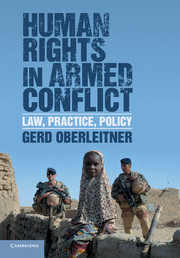Book contents
- Frontmatter
- Contents
- Acknowledgments
- Table of cases
- Table of Legal Instruments
- List of Abbreviations
- Introduction
- Part I Human rights in armed conflict: history of an idea
- Part II Human rights and humanitarian law: theory
- 5 Exclusivity: the misconceived idea of lex specialis
- 6 Complementarity: maximizing protection
- 7 Integration: the transformative influence of human rights
- Part III Human rights and humanitarian law: challenges and commonalities
- Part IV The dynamics of war and law
- Part V Enforcement: practice and potential
- Conclusion
- Bibliography
- Index
- References
7 - Integration: the transformative influence of human rights
Published online by Cambridge University Press: 05 March 2015
- Frontmatter
- Contents
- Acknowledgments
- Table of cases
- Table of Legal Instruments
- List of Abbreviations
- Introduction
- Part I Human rights in armed conflict: history of an idea
- Part II Human rights and humanitarian law: theory
- 5 Exclusivity: the misconceived idea of lex specialis
- 6 Complementarity: maximizing protection
- 7 Integration: the transformative influence of human rights
- Part III Human rights and humanitarian law: challenges and commonalities
- Part IV The dynamics of war and law
- Part V Enforcement: practice and potential
- Conclusion
- Bibliography
- Index
- References
Summary
Neither genus nor species
“Exclusivists” and “complementarists” may differ in their arguments: while the former argue for the precedence of humanitarian law, the latter seek to reconcile differences in the application of norms by way of interpretative techniques to achieve a coherent legal framework for armed conflicts which still acknowledges the primacy of humanitarian law, at least in certain circumstances. But both schools of thought agree that the distinctiveness of the two legal regimes needs to be preserved, and deny and reject any further integration of human rights into humanitarian law. From 1945 onwards, however, there was precisely this third view which argued that human rights and humanitarian law need to be seen as an integrated legal regime. Again, the boundaries between these different concepts are fluid and somewhat artificial: if one sees complementarity as a static phenomenon, one is likely to argue for keeping human rights and humanitarian law separate; if one sees complementarity as a process, one may agree that eventually the two fields may merge.
As in the other two theoretical approaches, there is no shortage of variations of the general theme of “integration.” Obviously, the idea of a (formal) complete identity of the two legal regimes is as incorrect as the strictly separatist view. Sometimes the common heritage of human rights and humanitarian law is emphasized and they are presented as two branches growing from a common stem. At times the relationship between international humanitarian law and international human rights law is also described in analogy to that between genus and species, which, in analogy to biological taxonomy, allows seeing one legal regime as a subset of another. Usually human rights are considered as “the genus of which humanitarian law is a species.”
- Type
- Chapter
- Information
- Human Rights in Armed ConflictLaw, Practice, Policy, pp. 122 - 128Publisher: Cambridge University PressPrint publication year: 2015



